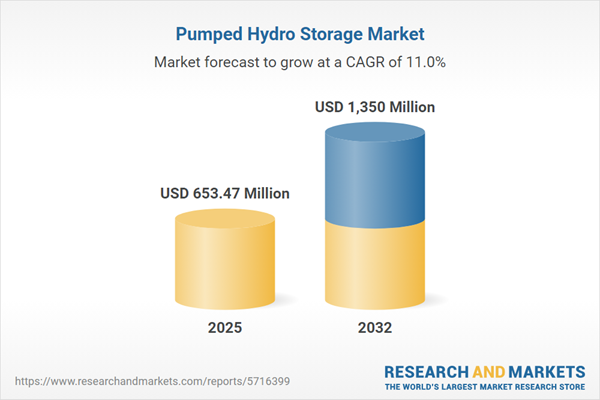Speak directly to the analyst to clarify any post sales queries you may have.
Pumped hydro storage is rapidly gaining traction as a central component in modern energy infrastructure, empowering senior decision-makers to address the evolving demands of renewable grid integration and system flexibility.
Market Snapshot: Pumped Hydro Storage Market Growth and Outlook
The Pumped Hydro Storage Market grew from USD 589.68 million in 2024 to USD 653.47 million in 2025. This sector is projected to expand at a CAGR of 11.00%, reaching USD 1.35 billion by 2032. Increasing deployment of solar and wind energy resources is placing a premium on proven, large-scale storage technologies, driving significant investments and innovation across multiple regions.
Scope & Segmentation
This report provides a comprehensive breakdown of the pumped hydro storage sector, examining a wide range of market variables and segmentation domains:
- Project Development Stage: Operational assets, planned sites (including long-term and near-term), and facilities under construction.
- Capacity Range: Projects segmented into 100 to 500 MW, above 500 MW (500 to 1000 MW, and above 1000 MW), and below 100 MW (50 to 100 MW, and below 50 MW).
- End User: Commercial, independent power producers, industrial entities (chemical, manufacturing, mining), utilities (investor-owned and public).
- Technology Type: Off-stream systems, on-stream systems.
- Application: Bulk energy storage, frequency regulation, grid stability, peak shaving.
- Ownership Model: Private, public, and public-private partnership configurations.
- Geographical Coverage: Americas (including North America and Latin America), Europe, Middle East & Africa, Asia-Pacific, covering major countries such as the United States, China, India, Germany, and Australia.
- Company Coverage: Detailed profiles and analysis of industry leaders such as Andritz AG, Voith GmbH & Co. KGaA, General Electric Company, Toshiba Energy Systems & Solutions Corporation, Fuji Electric Co., Ltd., Mitsubishi Heavy Industries, Ltd., Bharat Heavy Electricals Limited, Hitachi Energy Ltd, Doosan Heavy Industries & Construction Co., Ltd., and Siemens Energy AG.
Pumped Hydro Storage Market: Key Takeaways for Senior Decision-Makers
- This market is benefiting from established operational history and the scalability of pumped hydro solutions, positioning it as a strategic asset for grid balancing as renewable integration accelerates.
- Technological advancements, such as variable-speed pump-turbines, new composite materials, and digital platforms, are enhancing both asset efficiency and lifecycle performance.
- Regulatory structures are increasingly recognizing the strategic value of long-duration storage, with new incentives and streamlined permitting facilitating project development in key jurisdictions.
- Leading players are deploying joint ventures, consortia, and advanced digital systems to strengthen project execution, maximize efficiency, and manage risk across complex value chains.
- Distinct end-user priorities drive tailored development, with commercial, utility, independent producer, and industrial sectors each pursuing specific resilience, operational, and financial objectives.
- Ownership and application models are diversifying, including private, public, and partnership-oriented frameworks suited to different risk profiles and regional market conditions.
Tariff Impact on Pumped Hydro Storage Value Chains
Recent tariff changes in the United States, specifically on imported equipment and critical materials such as steel and turbine components, are reshaping procurement strategies. Project stakeholders are responding with domestic investment, alliance-building, and realignment of supply chains to minimize exposure to import duties and project delays. International suppliers are adapting pricing and logistical tactics to navigate this evolving trade environment, influencing global project scheduling and delivery.
Methodology & Data Sources
This research integrates primary interviews with developers, utilities, vendors, and regulatory authorities, and leverages secondary sources including government publications, industry reports, and technical studies. Competitive benchmarking, scenario analysis, and dedicated tariff modeling inform both qualitative and quantitative conclusions. Peer reviews and stakeholder workshops validate all insights.
Pumped Hydro Storage Market: Why This Report Matters
- Enables strategic alignment by delivering granular segmentation, technology, and regional analysis tailored for senior leaders assessing market entry, partnership, or expansion opportunities.
- Provides actionable insights into regulatory, financial, and supply chain shifts that directly impact procurement, investment, and project timelines.
- Supports robust risk management by quantifying potential impacts of policy changes and outlining proven mitigation approaches.
Conclusion
The pumped hydro storage sector is positioned as an adaptable, strategic solution in the transition toward resilient and sustainable energy systems. Leveraging operational expertise, technology innovation, and regional opportunity will enable industry leaders to secure long-term value and reliability.
Additional Product Information:
- Purchase of this report includes 1 year online access with quarterly updates.
- This report can be updated on request. Please contact our Customer Experience team using the Ask a Question widget on our website.
Table of Contents
3. Executive Summary
4. Market Overview
7. Cumulative Impact of Artificial Intelligence 2025
Companies Mentioned
The companies profiled in this Pumped Hydro Storage market report include:- Andritz AG
- Voith GmbH & Co. KGaA
- General Electric Company
- Toshiba Energy Systems & Solutions Corporation
- Fuji Electric Co., Ltd.
- Mitsubishi Heavy Industries, Ltd.
- Bharat Heavy Electricals Limited
- Hitachi Energy Ltd
- Doosan Heavy Industries & Construction Co., Ltd.
- Siemens Energy AG
Table Information
| Report Attribute | Details |
|---|---|
| No. of Pages | 186 |
| Published | November 2025 |
| Forecast Period | 2025 - 2032 |
| Estimated Market Value ( USD | $ 653.47 Million |
| Forecasted Market Value ( USD | $ 1350 Million |
| Compound Annual Growth Rate | 11.0% |
| Regions Covered | Global |
| No. of Companies Mentioned | 11 |









